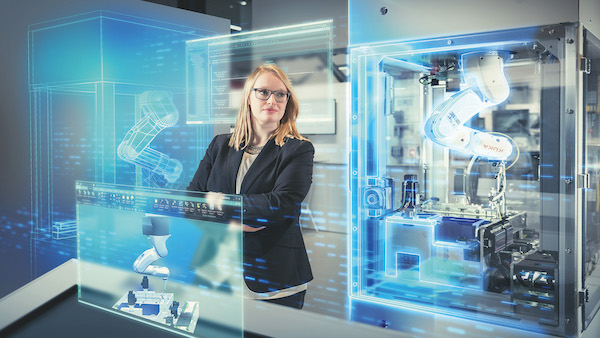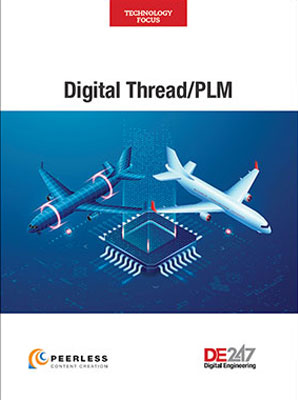Defining the Advantages of Advanced Machine Engineering
Advanced machine engineering (AME) accelerates the development of smart machine solutions for manufacturing.

September 20, 2021
Pioneering technologies are quickly advancing machine engineering processes to drive a positive change in the manufacturing industry, prompting companies to meet machinery manufacturers' challenges and trends. These trends consist of consumer-driven customization that results in smaller lot sizes and product life spans. Thus, smart machines provide an increase in information flow through hyper-automation to leverage vast amounts of data that automate machine functions and global competition from flexible, agile startups.
Advanced machine engineering (AME) has become more prominent in recent years. It focuses on ensuring greater certainty in developing next-generation machines by fostering collaboration among the multiple disciplines required to create today's advanced machines. Also, it reduces ramp-up time from production through virtual design and commissioning, resulting in better upfront validation, shorter commissioning times, and more immediate productivity. Subsequently, advanced capabilities are available to manage the entire bill of materials for all options and variants for advanced machine builder support throughout the product life, from the engineering design through manufacturing and service life.
Advanced Machine Engineering Differentiators
There are influential capabilities within AME's essential differentiators to impact the machine industry positively.
Multi-disciplinary design – Machines are not merely a mechanical piece of equipment. Electrical motors and rotary equipment that moves camshaft gears are driven by software and PLC codes, thus accelerating performance-based programs in recent years. This software is very adaptable to many conditions on the factory floor, enabling the machine to react to real-time sensor readings. The multi-disciplinary design includes machine building complexities, with engineering the design and manufacturing. It creates a single source of truth in design to address the back-and-forth process between engineering silos.
Virtual machine simulation and commissioning indicates how the machine validates the software code in the virtual world before physically operating on the factory floor. The behavior of the machines is driven by software, which is why it is essential to simulate the code running on a virtual twin of the machine to generate substantial dividends in time and resources. The PLC software validates in a managed environment with a complete modular product development strategy through virtual commissioning. Then machine builders can simulate upfront and link the software to the modules. This process is a groundbreaking achievement for keeping companies competitive in this space. Using a digital twin allows engineers to simulate and validate more concepts faster without prototyping to make better decisions by selecting the best concept.
Furthermore, virtual simulation proves the physical safety factor by showing if a machine collides in the virtual world, thus making it substantially safer and less costly to fix than on a physical machine. A notable example of virtual commissioning is Tronrud Engineering, which for more than 40 years have developed, produced, and delivered innovative machines and equipment. A digital twin of the new machine allows designers, engineers, and programmers to work simultaneously and endlessly to interact and share their knowledge. By implementing virtual commissioning and simulation, Tronrud Engineering reduced their commissioning time up to 70 percent while compressing their engineering time by 25 percent. A substantial benefit to their bottom line.
Multi-disciplinary BOM and configuration management provides manufacturers superior flexibility to respond to customer demands for customization, as most modern machines are configured to order. Every machine and order that a machine builder receives is often a new project. Engineer to order increases development and production costs, so the solution is to modularize machines more intelligently with each “unique” machine configured to order. Therefore, it is essential for machine builders to track the diverse options and variants for integrating requirements and project change management to manage the entire BOM throughout the product life. This process includes the original engineering design, manufacturing, and managing of the machine bill of materials throughout its service life. This methodology provides a capability for ensuring and reducing the risk of meeting customer requirements to enable sophisticated software solutions implemented into every machine.
Smart Machines, Smart Code and Smart Software
Innovative software is essential for machine manufacturers facing competitive globalization, shrinking margins, rapidly expanding customization, environmental and government regulations, and Industry 4.0 initiatives. All these significant challenges require machines to be smarter.
The core requirements include machine design innovation in the operation and development process. Being good versus extraordinary depends on the quality and innovation in the automation code. Having exceptional code provides intuitive user interfaces, promoting ease of use and new hardware capabilities. In addition, it is using software algorithms to help machines move faster and more safely with less physical stress on components.
Unfortunately, well-written code is not always enough. Current machines have tremendous complexity in their lines of code. Therefore, it is critical to test that code in a virtual world, running it through all use cases before loading it on a physical machine. In addition, companies face the pressure to deliver highly customized machines rapidly, with further complexity. Consequently, it is no longer possible to rely on and safely physically validate the machine.
Therefore, every machine is released to the customer with binaries representing the compiled machine operation and user interface code. With traditional methods, programmers scramble to get last-minute changes to the code completed before the machine ships out.
In this chaotic environment, it is imperative to retain a locked version of the final code for essential purposes, including service, catastrophic backup, lessons learned for future machines, and upgrades to previous machines in the field. However, having a code repository is not adequate. Each software variant must be traceable and retrievable through the serial number for the machine bill of materials. Also, a machine's life needs traceable records of all upgrades in hardware and software that represent the machines' living digital twin.
AME Software Solutions
Advanced machine engineering solutions are emerging that address the challenges and trends facing the machinery industry. These include multi-discipline design, virtual machine simulation and commissioning and multi-disciplinary BOM and configuration management.
Siemens Digital Industries Software is driving transformation to enable a digital enterprise where engineering, manufacturing and electronics design meet tomorrow. The Xcelerator portfolio helps companies of all sizes create and leverage digital twins that provide organizations with new insights, opportunities, and levels of automation to drive innovation.
For more information on Siemens Digital Industries Software products and services, visit www.sw.siemens.com or follow us on LinkedIn, Twitter, Facebook and Instagram.
Siemens Digital Industries Software – Where today meets tomorrow.

Rahul Garg is Vice President of Industrial Machinery and the SMB Program for Siemens Digital Industries Software. He and his team are responsible for identifying and delivering strategic initiatives and developing solutions for the industry, working closely with industry-leading customers and providing thought leadership on new, emerging issues facing the machinery industry. Rahul’s experience and insights are derived from a 25-year career of delivering software-based solutions for product engineering and manufacturing innovation for the global manufacturing industry. He has held leadership positions in multiple areas, including research and development, program management, sales and P&L management, having focused exclusively on the industrial machinery and heavy equipment industry since 2007. Rahul holds a master’s degree in Computer Science from Wayne State University, with a concentration in Operations Management and Strategic Marketing, as well as a Bachelor of Computer Engineering degree in Computer Engineering from Bombay University.
More Siemens Digital Industries Software Coverage
Subscribe to our FREE magazine, FREE email newsletters or both!






